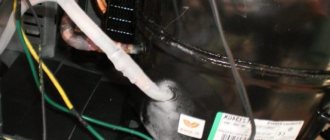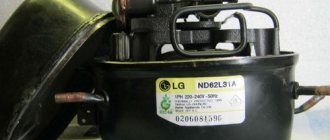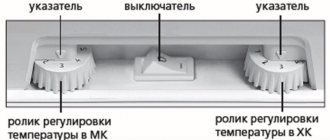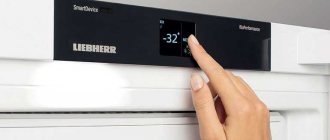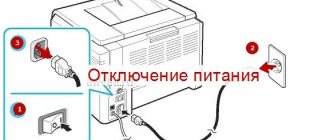Causes and signs of a refrigerant leak
By some signs you can find out how to determine a freon leak:
- The quality of system cooling gradually decreases. The equipment does not freeze well, and the food is poorly refrigerated.
- Continuous operation of the compressor with rare breaks, which is important when there is insufficient cooling.
- The compressor does not start and there is no cooling due to a freon leak in the refrigerator.
- Information about the problem appears on the small screen. Some models have indicators that flash red.
Upon preliminary inspection, you can notice a layer of snow on the evaporator, which appears in a short time. If you can’t figure out what the problem is on your own. It is better to contact specialists who will tell you how to understand that freon has leaked from the refrigerator and will help you get rid of the problem.
Snow on the evaporator
The main reason that freon leaked was non-compliance with certain operating rules:
- inaccurate transportation and unloading causes destruction of the seams;
- using a knife or fork to speed up defrosting can damage the tubes;
- lack of regular defrosting leads to ice accumulation and gradual rusting;
- long service life and corrosion;
- fulfillment of defects at the factory.
If there is little refrigerant, the compressor runs constantly, but the chamber is warm. A technician with a special tool can understand what happened and find the breakdown.
Checking system pressure
If the leak is not eliminated in a timely manner, problems with the functioning of the equipment and subsequent failure may occur. If moisture leaks into the circuit, acid will appear, which will cause corrosion and combustion of the windings in the compressor. A lack of cooling component allows air to enter the system. When refrigerant leaks, oil may also leak. Lack of cooling provokes overheating of the main device and its failure.
All these consequences of a lack of a cooling component greatly reduce the service life of the equipment.
Why do you need freon
Not all people know what function the refrigerant performs. Freon is the main working substance that removes heat from the compartments of the refrigerator. Therefore, the required temperature is maintained in the internal chambers.
If there is not enough gas or it leaks, the equipment stops working normally or fails completely. It is important to be able to detect freon leaks and know through which places it comes out.
To better understand why refrigerant is needed, you can familiarize yourself with the operating principle of a household appliance motor:
- the compressor relay turns on, closing the electrical circuit, when the temperature rises, and when the cold blower operates, the required pressure is created in the system so that the gas enters the condenser radiator;
- the refrigerant becomes liquid and a large amount of heat is generated, dissipating into space thanks to the radiator grille;
- after passing through the evaporator, the substance ends up in the pipeline, where the pressure equalizes and gradually decreases;
- liquid refrigerant enters the radiator and is heated to a predetermined temperature, and then turns into steam;
- The condenser cools and the temperature in the refrigerator decreases.
Some believe that freon is harmful to the human body. However, it only becomes dangerous if there is a large gas leak. There is a small amount of it in the refrigerator. For example, Atlant devices contain 60-135 g of freon. The exact amount of refrigerant depends on the model of household appliance.
View » What to do when the refrigerator crackles during operation and clicks loudly from behind
How to find a freon leak in a refrigerator yourself at home
The appearance of an unpleasant odor is evidence of refrigerant leakage. Although the freon from the refrigerator does not smell anything, when it evaporates, the microclimate in the device changes, and pathogenic microorganisms are formed that cause the odor. A heavy odor may be caused by a clogged drainage system. In this case, it is enough to clean the capillary tubes. Unpleasant odors also occur when equipment is not properly maintained. If there is a burning smell, most likely the compressor has broken down due to a lack of refrigerant.
Therefore, it is impossible to know exactly what kind of smell freon has, but to identify the problem you need to perform the following steps:
- Monitor the operation of the compressor to note the start time.
- Inspect the tightness of the seal along the contour. You should try pulling a thin strip of paper through the closed door. If this is difficult to do, the seal is fine.
- It is important to check the network. If there is a power failure, there will be no compression.
In such situations, the problem does not arise from a refrigerant leak. You can do simple manipulations at home; if the problem persists, you need to seek professional help.
Search in accessible places
To find leaks in accessible places, specialists use the following methods:
- use a foam solution where oil stains appear;
- use liquid. This method allows you to identify depressurization of removable elements. The device is filled with nitrogen, sealed and lowered into water. Additionally, soap is added;
- A halogen device is used to help detect the leakage of refrigerant containing chlorine. The device is effective in detecting small cracks;
- ultraviolet dyes are poured into the device;
- Punctures can be detected using high pressure. If the pressure is insufficient, filling with dry nitrogen is used. When it leaves the system, you can hear a noise at the crack site;
- Ultrasound diagnostics detect leakage sounds that humans cannot hear. A special device will help if there is pressure in the system.
Soap solution test
Effective methods include a test with a soap solution. It is very easy to make, but can also be purchased in stores. This may be a solution in an aerosol package or a product with added additives or in a set with brushes. After completing the spray application procedure, you must remember to remove its residues, as they contain corrosive active ingredients.
Search in hidden places
Difficulties arise with internal leaks. You can notice the problem by the swollen walls. And to determine hidden leaks, an electronic leak detector is used. This mechanism reveals small cracks.
What does a freon leak look like in a refrigerator?
If refrigerant is leaking, this can be determined by inspection. The breakout area becomes a black spot and oil remains around. If the puncture is in the closed part, the chamber wall will swell.
If freon leaks from the refrigerator, the chamber will be warm and an oily puddle will appear on the floor. When the refrigerant enters the room, it evaporates and leaves behind oil, condensate and decomposition products. The cold grille on the front side is also an indicator.
The specialist knows exactly how to find a freon leak in the refrigerator. For this purpose, there is a special device that sounds a sound signal when a violation of integrity is detected.
Internal freon leak in refrigerator
Difficulties arise if a freon leak occurs inside the device. In such a situation, it is necessary to change the refrigerant circuit. If there is a breakthrough in the door circuit, the tube is laid along the rear surface. If there is a breakthrough in the housing, the specialist removes the insulation and makes the circuit again. It is very difficult to restore the operation of equipment after such a breakdown. And some companies that have a refrigerator under warranty do not repair the equipment, but provide a replacement.
Leak inside refrigerator
How to find and fix freon leaks at home?
Signs
This can be determined at home by the following signs:
- The temperature in the refrigerator compartment has become higher and is poorly regulated.
- Constant uninterrupted operation of the compressor.
- The device makes gurgling sounds.
- Frost on the inside surface of the refrigerator.
- Ice on the pipes near the compressor.
- The refrigerator does not turn on.
- The wall of the refrigerator is swollen.
- The equipment makes sounds indicating a malfunction.
What to do?
The appearance of one of these signs does not mean that a freon leak has occurred. But if it does exist, then the sequence of actions should be like this:
- Locate the leak
- Determine the cause of its occurrence
- Fix the leak.
Since freon circulates through a sealed system, it cannot evaporate or run out. Therefore, simply refilling freon will not solve the problem. The easiest way to determine that a leak has occurred is to check the safety of perishable products. If they deteriorate very quickly, then the refrigerator does not maintain the set temperature, which means freon has leaked out.
Unfortunately, it will not be possible to visually determine the problem, since freon is a colorless gas or odorless liquid. And if liquid leaks from the refrigerator, then it is compressor oil. If this happens, then freon also comes out, because during the operation of the refrigerator they mix. This means we need to look for the leak.
How to find freon leaks
- Visually. There is a large accumulation of ice and snow at the leak site due to the cooling of freon during evaporation. To do this, you need to inspect the entire system, having first removed the plastic from both the refrigerator and freezer compartments.
- Using a soap solution. Approximate area of depressurization is coated with a concentrated soap solution at a minimum temperature in both chambers. Soap bubbles appear in the area where the leak occurs. This only works if the damage is severe. If it's small, it's unlikely to work.
- Using ultraviolet light. During refrigerator maintenance, specialists add UV markers to the freon. Therefore, with this method of determining a leak, we will need an ultraviolet flashlight.
The test is carried out in the dark and with the compressor running. There will be a colored spot where the leak occurs. If there was no UV marker in the cooling system, it can be added at any time by contacting a specialist.
- Using a special device - a gas analyzer. Each type of freon has its own device that reacts specifically to it. To check, they need to check the entire system.
- Using a leak detector. Externally, the device looks like a metal detector, and begins to beep as it approaches the leak. With its help you can even find microcracks in hard-to-reach places.
Fixing a freon leak in a refrigerator
Various methods are used to restore tightness. Soldering is used to repair damage in the evaporator. Argon welding is used to join aluminum and copper pipes. In some cases, the leak occurs at the junction of the compressor and the fitting, and the circuit may not require repair. To troubleshoot the problem, the specialist performs the following steps:
- Carrying out diagnostics. The technician must understand why freon is leaking from the refrigerator.
- Detection of cracks and punctures in circuit tubes.
- To remove residual refrigerant and condensate, the system is evacuated.
- The circuit is filled with gas in the required volume.
- The technician must check the equipment for leaks.
Repairing Freon Leaks
Even after pumping in freon, the cooling effect may not be fully restored. May need refilling.
How to Determine a Leak
The gas used in refrigeration equipment is colorless and odorless; the main sign of freon leakage from the refrigerator is an increase in temperature in the internal chambers during constant operation of the compressor. On models equipped with 2 cooling circuits, the defect can be traced only on one of the chambers. The compressors of the equipment are switched off only after all the refrigerant has left the circuit. Due to insufficient lubrication and cooling, the rubbing surfaces are damaged, so the user needs to detect a gas leak as early as possible.
On some products equipped with a microprocessor and a control display, an error code is displayed. A malfunction occurs when there is a loss of pressure in the circuits; the triggered sensor gives a signal that allows you to detect a freon leak. The explanation of error codes is given in the operating instructions. An additional indicator of failure is the cold surface of the condenser grill; under normal operating conditions, the part heats up.
The owner can detect signs of freon leakage at home by visual signs.
When a crack appears on the evaporator, a coating of frost and ice appears on the surface, which is a characteristic symptom of a freon leak in the refrigerator. Another sign of a problem is swelling of the back cover, caused by ice forming in the gap between the walls. When removing ice from the surface of the freezer, users pierce the jacket; due to the increased size of the hole, pressurized gas comes out with noise.
Soldering
To eliminate cracks, a soldering method is used, which includes the following manipulations:
- The soldering area is carefully prepared. To do this, insulation is carried out using asbestos gaskets that protect the elements from the burners;
- puncture areas are sealed with solder with a silver base and a special paste;
- dryer filters are being replaced;
- The treated areas are checked for leaks.
If the sealing is done correctly, the specialist proceeds to filling the circuit with freon. Injection is carried out through the Schrader valve. The refrigerant is taken from a special cylinder.
How to recognize a freon leak from a refrigerator
First, let's briefly define the role of the coolant in the smooth operation of the device. Freon is a chemical compound based on methane and ethane with the replacement of some atoms. This is the so-called refrigerant, which circulates according to a circuit and, in a certain state of aggregation, takes heat from the refrigeration chamber, transferring it to the environment.
Accordingly, a decrease in the volume of freon leads to the fact that the system becomes unable to maintain a low temperature inside the refrigerator or freezer for a long time, i.e. The refrigerator does not fulfill its direct duties. It is worth noting that since the gas itself is odorless and colorless, owners most often find out about the problem due to spoiled products. This is the first sign of a freon leak from the refrigerator - the temperature inside is close to room temperature.
The second sign that helps to clarify that the problem is in the refrigerant, and not in a malfunction of the thermostat or motor-compressor, is the temperature of the condenser itself. In normal operating condition, gas heated to 70 degrees cools down in it as a result of compression. Accordingly, if the tubes remain cold after prolonged operation, the problem is the depressurization of the system.
The cause of freon leakage from the refrigerator is most often mechanical. Damage may occur as a result of careless transportation of the device or failure to de-ice it (users often use knives or other sharp objects for this, which is generally prohibited). This can also happen over time. Experts generally recommend changing the refrigerant every 1-3 years, but this trend has not caught on here and repair work is traditionally started when the breakdown is already obvious.
Without repair
In cases where the breakdown is associated with clogged filters or capillary pipes, no repairs are made. To get rid of the problem, just clean it. If liquid has entered the cooling circuit, you will need to remove the filter drier. After fixing the problem, it is necessary to restore the required amount of gas. Refueling should be done by specialists. After refueling, you need to check the functionality of the cameras. If the tubes that enter the circuit begin to freeze, it means that freon has been added in excess.
Excess freon
Leak testing is also performed. If necessary, moisture is removed from the circuit. A vacuum device is used for this.
Freon leak using the example of the Atlant refrigerator: repair and replacement
If you have a refrigerator “Indesit”, “Nord”, “Atlant” or any other model of a common brand, the procedure for carrying out repair work will be almost identical. And it consists of the following steps:
- Detection of gas leakage . A specialist visually inspects the electrical appliance, looking for visible “symptoms” - rust or swelling. Then, using a leak detector that records the concentration of freon vapor in the air, it finds the exact location.
- Neutralization of leakage . Work is underway to eliminate the leak and focus on its location. If the place is "affordable", it's no big deal. So, if the leak is a “warm” circuit, the defective area is cut out and the system is looped. And if the refrigerant comes out of the foamed part, the technician chooses the safest method of repair.
It all depends on the brand, model of the refrigerator and the experience of the technician. In some cases, it is advisable to repair the foam part of the body - there are models in which it is not necessary to completely remove all the insulation. And in some cases, you need to attach a new evaporator, so you don’t have to open the housing - such work can be done right at your home. Breakdowns are possible when you need to completely “unseal” the wall.
- Installing a new filter drier . This element is always replaced if a leak occurs, so when the technician tells you to replace it, he is not trying to deceive or “sell” unnecessary parts. Replacement is necessary to prevent moisture particles from entering the cooling circuit.
- Checking 100% tightness . To check the degree of sealing of the system, the mechanic injects nitrogen into the circuit. Checking the pressure gauge, the technician monitors the pressure. If the test is successful, the gas is released, and the repairman proceeds further according to plan.
- Vacuuming . To remove air and moisture from the circuit, special vacuum equipment is used. It is connected using a Schrader valve, after which pumping occurs until the desired vacuum level is reached.
- Recharging refrigerant . Coming to the finish line, the master selects the appropriate refrigerant and refills it. It is also introduced into the system through the Schrader valve, after which freon is pumped into the circuit from the cylinder. The level of gas injection is determined based on the manufacturer's requirements. The degree of filling is controlled by a pressure gauge or by taking into account the mass - then the cylinder is weighed.
- Examination . After finishing the filling, the specialist makes sure that the refrigerator is working and gives you a package of warranty documents.
Important! Always ask for a warranty, even if the refrigerator immediately turned on and started freezing. There are times when craftsmen “overdo it” with the refrigerant, and the excess needs to be released. To avoid paying for repairs again, you need documents confirming the work.
Let's summarize our review. If there is a freon leak, you can find the damaged area yourself to save on diagnostics. And you don’t need to save on repairs - contact trusted companies. Follow the work of the master, checking the progress of work described by us.
How to determine what freon is in your refrigerator
Freons consist of a mixture of ethane and methane, in which hydrogen atoms are used instead of chlorine and fluorine atoms. In a refrigerator, the refrigerant evaporates and condenses into a liquid. As a result, cooling occurs. The industry produces more than 40 varieties of freons. But only some of them are used for household appliances.
To find out what kind of freon is in the refrigerator, you need to look at the technical documentation. Here manufacturers indicate the characteristics of the equipment. The type of refrigerant is also indicated on the compressor.
Initially, R 12 freon was used in refrigerators. It was used in the production of models such as Zil and Dnepr. This substance was highly effective, but was banned due to its low environmental friendliness. Among the advantages, it is worth noting the low cost, the ability to replace with other refrigerants and high performance. The disadvantage is the high noise level.
R12 was replaced by R134A or tetrafluoroethane. When this refrigerant is used, the compressors use synthetic oil. This component does not dissolve oil well, as a result of which it is not completely returned to the compressor. This causes blockages in the capillary pipes. Among the advantages, it is worth noting the high cooling capacity. There are also some disadvantages. Freon cannot be replaced with other alternatives.
The new refrigerants include R600A, which is suitable for class A equipment. Equipment running on this freon is characterized by low energy consumption and noise. This was achieved through the use of compressors with reduced power levels. The disadvantages of the refrigerant include the risk of explosion, but this component is so small that it is not dangerous for users. When repairing equipment with such a refrigerant, fire safety regulations must be observed. The advantages include the possibility of replacement with other refrigerants.
How can you tell if your refrigerator has run out of freon?
It is worth saying that freon is not a fuel; it does not run out. The refrigerant circulates through a sealed system. If there is a suspicion that gas has escaped, this means that there is a break or leak. There is no point in refilling freon without eliminating the problem.
If the refrigerant leaves the circuit, the efficiency of the refrigerator decreases. It does not maintain the set temperature and cools the food slowly. How to understand that the refrigerator has run out of freon - check the safety of perishable foods.
Due to a lack of refrigerant in the circuit, the cooling capacity of the refrigerator is reduced. Food and prepared meals are constantly heated and cooled. This affects their safety. If the food in the refrigerator begins to spoil, this is a clear sign that there is a freon leak.
Where is the highest probability of leaks?
Refilling equipment with freon is not that difficult. But to carry out repairs, it is necessary to correctly determine the location of the leak. To quickly determine the presence of cracks, it is important to know the problem areas in the equipment:
- Pipe soldering areas. The internal contour consists of elements that are joined by soldering. During the production process, joints may be welded poorly. As a result, small cracks appear at the joints, through which coolant slowly flows out.
- An evaporator that is placed inside the equipment. It is made from thin metal. When leaks appear, a layer of frost appears on the surface of the device. After removing it, you can fix the problem. A crack is difficult to repair if it is on the inside.
- Freon circulates in the heating circuit. Gas flows inside the system from the internal chambers and to the compressor. As a result, excess heat is removed. This device is used to eliminate condensation, so corrosion may occur.
Once the leak is detected, the problem can be fixed. If you have the skills, the problem can be fixed on your own. But in order for the work to be done efficiently, it is worth contacting a specialist.
Where do leaks most often occur?
Regardless of the brand and model of equipment, freon most often leaks from the following components:
- Leaks at solder joints. The most common case. The reason for this may be a manufacturing defect or mechanical damage during operation.
Refrigerant leak from factory soldering
- In a crying evaporator. Most often, this part is made of aluminum and is susceptible to rust. Moisture that accumulates in the evaporator leads to corrosion. As a result, small cracks form, through which the volatile refrigerant escapes. In modern models, the evaporator is often foamed, which causes additional difficulties in repair. If the leak occurs in the foamed part, complex manipulations with disassembling the housing will be required.
"Crying" refrigerator evaporator
- Gas has escaped from the heating circuit. This unit, due to constant contact with moisture, is prone to corrosion, which is why this happens. The likelihood of a malfunction increases as the “lifespan” of your equipment increases.
